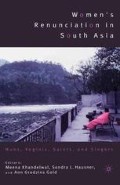Abstract
“It’s beautiful. It’s red,” Tara said in a letter to me describing the cow she bought with the money I had sent. Her mention of the red cow recalled to me the times when she had spoken of the traits of this specific color. Red was the color her guru had given her when she became initiated as a Vaishnava Baul. It reflected the power of menstrual blood containing female procreative seed, esteemed by Tara and her kin for its beneficent properties. Other bodily secretions such as urine, tears, and mother’s milk were also held to be benevolent, yet menstrual blood was particularly valuable. Tara described the female substance as the true river Ganges, bearing the same sacred powers in concentrated form. During her ceremony of initiation, when she received a sannyas mantra, her sari, blouse, and underskirt had all been red. The color varied from pink and crimson to bright brown and saffron and, like other Bauls, Tara wore these shades in combination.
Access this chapter
Tax calculation will be finalised at checkout
Purchases are for personal use only
Preview
Unable to display preview. Download preview PDF.
Bibliography
Alter, Joseph S. 1992. The Wrestlers Body: Identity and Ideology in North India. Berkeley: University of California Press.
Alter, Joseph S. 1997. Seminal Truth: A Modern Science of Male Celibacy in North India. Medica/Anthropo/ogy Quarter/y 11 (3): 275–298.
Bottéro, Alain. 1991. Consumption by Semen Loss in India and Elsewhere. Culture, Medicine and Psychiatg 15: 303–320.
Capwell, Charles. 1986. The Music of the Bauls ofWest Bengal. Kent, OH: Kent State University Press.
Cort, John. 1999. The Gift of Food to a Wandering Cow: Lay-Mendicant Interaction Among the Jains. Journal of Asian and African Studies 34: 89–109.
Daniel, E. Valentine. 1984. Fluid Signs: Being a Person the Tamil Way. Berkeley: University of California Press.
Fuller, C.J. 1992. The Camphor Flame: Popular Hinduism and Society in India. Princeton, NJ: Princeton University Press.
Gold, Ann Grodzins, and Bhoju Ram Gujar. 2002. In the Time of Trees and Sorrow: Nature, Power, and Memory in Rajasthan. Durham: Duke University Press.
Gold, Daniel. 1999. Nath Yogis as Established Alternatives: Householders and Ascetics Today. Journal of Asian and African Studies 34 (1): 68–88.
Hanssen, Kristin. 2002. Ingesting Menstrual Blood: Notions of Health and Bodily Fluids in Bengal. Ethnology 41 (4): 365–379.
Hanssen, Kristin. 2000. A tigge er en plikt: Vaishnava baulers tro og praksis. In Ncerbilder av India: Samfunn, politikk og utvikling, Kathinka Froystad. Eldrid Magerli and Arild Engelsen Ruud, eds., pp. 104–128. Oslo: Cappelen akademisk forlag.
Hart, George. 1973. Woman and the Sacred in Ancient Tamilnad. Journal of Asian Studies 32 (2): 233–250.
Khandelwal, Meena. 2001. Sexual Fluids, Emotions, Morality: Notes on the Gendering of Brahmacharya. In Celibacy, Culture, and Society: The Anthropology of Sexual Abstinence. Elisa J. Sobo and Sandra Bell, eds., pp. 157–179. Madison: University of Wiscons in Press.
Laidlaw, James. 2000. A Free Gift Makes No Friends. Royal Anthropological Institute 6: 617–634.
Lamb, Sarah. 2000. White Saris and Sweet Mangoes: Aging, Gender, and Body in North India. Berkeley: University of California Press.
Marriott, McKim. 1976. Hindu Transactions: Diversity Without Dualism. In Transactions and Meaning: Directions in the Anthropology of Exchange and Symbolic Behaviour. Bruce Kapferer, ed., pp. 109–142. Philadelphia: Institute for the Study of Human Issues.
Openshaw, Jeanne. 2002. Seeking Bauls of Bengal. Cambridge: Cambridge University Press.
Salomon, Carol. 1991. The Cosmogonie Riddles of Lalan Fakir. In Gender, Genre, and Power in South Asia. Arjun Appadurai, Frank J. Korom, and Margaret A. Mills, eds., pp. 267–304. Philadelphia: University of Philadelphia Press.
Trawick, Margaret. 1991 [1980]. On the Meaning of Shakti to Women in Tamil Nadu. In The Powers of Tamil Women. Susan Wadley, ed., pp. 1–34. Maxwell School Foreign and Comparative Studies, South Asian Series, no. 6, Syracuse University.
Trawick, Margaret. 1992. Notes on Love in a Tamil Family. Berkeley: University of California Press.
Urban, Hugh B. 1999. The Politics of Madness: The Construction and Manipulation of the ‘Gaul’ Image in Modern Bengal. Journal of South Asian Studies 22 (1): 13–46.
Editor information
Copyright information
© 2006 Meena Khandelwal, Sondra L. Hausner, and Ann Grodzins Gold
About this chapter
Cite this chapter
Hanssen, K. (2006). The True River Ganges: Tara’s Begging Practices. In: Khandelwal, M., Hausner, S.L., Gold, A.G. (eds) Women’s Renunciation in South Asia. Religion/Culture/Critique. Palgrave Macmillan, New York. https://doi.org/10.1007/978-1-137-10485-4_4
Download citation
DOI: https://doi.org/10.1007/978-1-137-10485-4_4
Publisher Name: Palgrave Macmillan, New York
Print ISBN: 978-1-349-73644-7
Online ISBN: 978-1-137-10485-4
eBook Packages: Palgrave Social & Cultural Studies CollectionSocial Sciences (R0)

